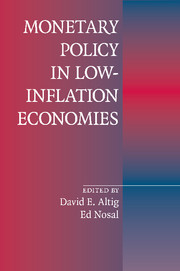Book contents
- Frontmatter
- Contents
- Contributors
- Acknowledgments
- Introduction
- 1 The Welfare Cost of Inflation in the Presence of Inside Money
- Commentary
- 2 An Open-Economy Model of Endogenous Price Flexibility
- Commentary
- 3 Efficient Inflation Targets for Distorted Dynamic Economies
- Commentary
- 4 Inflation and Welfare in Models with Trading Frictions
- Commentary
- 5 Good versus Bad Deflation: Lessons from the Gold Standard Era
- Commentary
- 6 Monetary Policy Orientation in Times of Low Inflation
- Commentary
- 7 Observations on Disinflation in Transition Economies
- Commentary
- 8 Inflation and Financial Market Performance: What Have We Learned in the Last Ten Years?
- Commentary
- Index
7 - Observations on Disinflation in Transition Economies
Published online by Cambridge University Press: 26 January 2010
- Frontmatter
- Contents
- Contributors
- Acknowledgments
- Introduction
- 1 The Welfare Cost of Inflation in the Presence of Inside Money
- Commentary
- 2 An Open-Economy Model of Endogenous Price Flexibility
- Commentary
- 3 Efficient Inflation Targets for Distorted Dynamic Economies
- Commentary
- 4 Inflation and Welfare in Models with Trading Frictions
- Commentary
- 5 Good versus Bad Deflation: Lessons from the Gold Standard Era
- Commentary
- 6 Monetary Policy Orientation in Times of Low Inflation
- Commentary
- 7 Observations on Disinflation in Transition Economies
- Commentary
- 8 Inflation and Financial Market Performance: What Have We Learned in the Last Ten Years?
- Commentary
- Index
Summary
The transition to market-based economies began just a little more than a decade ago in 27 countries of central Europe and the former Soviet Union. Most observers in the early 1990s thought that the transition process would be long and tedious. Early transition experiences seemed to support that expectation. Most of the transition countries experienced sharp initial declines in output, periods of rapid inflation—including many hyperinflations— and enormous political obstacles to reform. There was ample reason to believe that transition would be a specific area of concern to economists for many years to come. However, the unique transition experiences are largely past in most countries, and the term “transition economics” might even be disappearing from view. At the very least, the term is barely relevant in much of central Europe, although it is still applicable in the republics of the former Soviet Union and possibly China. That is not to say these countries are trouble free, but that they share problems that are common to other emerging market economies. However, some of the advanced transition countries are quickly leaving that status. Nothing symbolizes this more than the accession of eight formerly planned economies from the Baltics, central Europe, and the Balkans to the European Union in the spring of 2004.
The rapidity of the transition experience is well illustrated by the path of inflation in these countries. Not surprisingly, one of the first manifestations of transition was high inflation. The causes of these inflationary outbursts were classical.
- Type
- Chapter
- Information
- Monetary Policy in Low-Inflation Economies , pp. 215 - 253Publisher: Cambridge University PressPrint publication year: 2009



